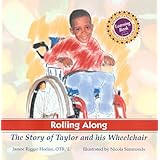
Author: Jamee Riggio Heelan
Illustrator: Nicola Simmonds
Grade Level: K-4
Buy Here! Resources SUMMARY: This book deals with cerebral palsy from a child's point of view. It is the story of Taylor and Tyler, twin brothers and best friends. They enjoy doing everything together. They have one challenge, Taylor has cerebral palsy and his twin brother does not. Taylor is limited in how far he can go with his walker because he gets tired easily and has to often take therapy to strengthen his legs. One day Taylor receives a surprise especially for him, his own wheelchair. This gave him the ability to play and join his brother in more physical activities. In a conversation with one of his friends, Taylor gets to explain why it is important and necessary for him to receive a wheelchair. This helped his friend to see the wheel chair as a great gift and he stopped feeling sorry for Taylor.
ELEMENT: Element 5 - Raising Awareness, provides a great example of what it is like to have a disability such as cerebral palsy and how important it is for disabled children to gain as much independence as possible. It does a great job of letting the readers know that the brothers are very much alike and do normal things together. It also raises awareness of the obstacles that disabled children in wheelchairs have to overcome when entering a building, going up stairs, opening a door, getting a drink of water or just going to the bathroom.
ACTIVITY: I would use this book to start a discussion on what it must feel like to be disabled. I would have the class write in their journals how do they think it would feel if they had a particular disability that affected their arms, legs, hearing, speech, thinking, etc. I would ask them to come together and discuss it as a class. We would make a list on the blackboard of all the obstacles disabled children face in order to attend school. Once the list is completed, we will discuss how the class can bring to the school's attention ways of making it easier for disabled students to get around in our school.
No comments:
Post a Comment